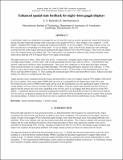| dc.contributor.author | Bachelder, E. N. | |
| dc.contributor.author | Hansman, R. John | |
| dc.date.accessioned | 2007-04-30T21:40:51Z | |
| dc.date.available | 2007-04-30T21:40:51Z | |
| dc.date.issued | 1997-04 | |
| dc.identifier.uri | http://hdl.handle.net/1721.1/37317 | |
| dc.description.abstract | A preliminary study was conducted to investigate the use of visual flow cues as an aid to ground and vertical drift awareness
during helicopter flight and targeting while using night vision goggles (NVG's). Three displays were compared: 1) NVG
display: simulated NVG image of cockpit and external environment; 2) Overlay display: NVG image with an overlay of a
flow cue field and a surrounding wire-frame globe; 3) Cut-out display: same as the Overlay display but with symbology
removed from the central region (leaving an unobscured 20 degree field-of-view of the NVG image). Three levels of contrast
were also compared using each display type. The visual scenery was displayed to subjects using a helmet-mounted virtual
reality device that had a 40 X 50 degree field-of-view liquid crystal display | en |
| dc.description.sponsorship | Charles Stark Draper Laboratory under grant DL-H-496004. | en |
| dc.language.iso | en_US | en |
| dc.subject | visual flow cues | en |
| dc.subject | vertical drift | en |
| dc.subject | helicopter flight and targeting while using night vision goggles | en |
| dc.subject | air transportation | en |
| dc.title | Enhanced spatial state feedback for night vision goggle displays | en |
| dc.type | Technical Report | en |
| dc.identifier.citation | Paper No. 3058-23, SPIE 1997 AeroSense Symposium Conference 3058: Head-Mounted Displays II, April 21-22, 1997, Orlando, FL | en |
